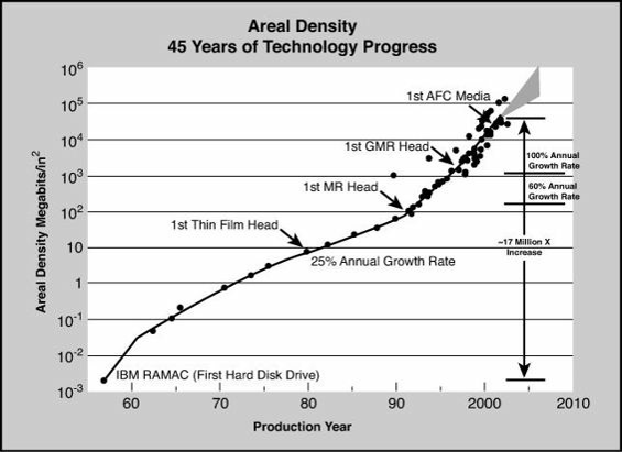Hardware Reference
In-Depth Information
Figure 8.13. Evolution of areal density in magnetic disk storage.
To increase areal density while maintaining the same external drive form factors, drive manufacturers
have developed media and head technologies to support these higher areal densities, such as
ceramic/glass platters, GMR heads, pseudo-contact recording, and PRML electronics, as discussed
earlier in this chapter. The primary challenge in achieving higher densities is manufacturing drive
heads and disks to operate at closer tolerances. Improvements in tolerances and the use of more
platters in a given form factor continue to fuel improvements in drive capacity, but drive makers
continue to seek even greater capacity increases, both by improving current technologies and by
developing new ones.
To fit more data on a platter of a given size, you must place the tracks more closely together, and the
heads must be capable of achieving greater precision in their placements over the tracks. This also
means that, as hard disk capacities increase, heads must float ever closer to the disk surface during
operation. The gap between the head and disk is as close as 10 nanometers (0.01 microns) in some
drives, which is approximately the thickness of a cell membrane. By comparison, a human hair is
typically 80 microns in diameter, which is 8,000 times thicker than the gap between the head and disk
in some drives. The prospect of actual contact or near contact recording is being considered for future
drives to further increase density.
Perpendicular Magnetic Recording
Originally all hard drives and other types of magnetic media recorded data using longitudinal
recording, which stores magnetic bits horizontally across the surface of the media. Today, however,
perpendicular recording, which aligns magnetic signals vertically on the media surface, is being
incorporated in modern drives to achieve higher data densities. This process works because
vertically oriented magnetic bits use less space than longitudinally stored bits (see
Figure 8.14
)
.
Virtually all the major drive vendors are working with perpendicular recording as a way to achieve
signal density surpassing what is achievable even with AFC pixie dust media.


